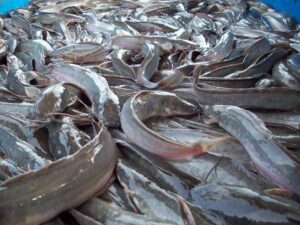Catfish production in Eastern Region sees significant boost
 Catfish production increased by 276.92 percent in the Eastern Region from 2018 to 2021 after the Fisheries Commission assisted producers with new technologies, extension services and training.
Catfish production increased by 276.92 percent in the Eastern Region from 2018 to 2021 after the Fisheries Commission assisted producers with new technologies, extension services and training.
Mr Francis Barnes, the Eastern Regional Director of the Fisheries Commission, who disclosed this to the Ghana News Agency, said in 2018 the Commission recorded about 60 catfish farmers who produced a combined total of 836.91 metric tons.
However, by 2021, the number of catfish farmers in the region had more than doubled to 128, raising production to 3,151.91 metric tonnes.
Mr Barnes linked the increased production levels to a slew of activities and sustained assistance provided by the Commission to catfish farmers and farmers in general who expressed an interest in catfish production.
Among the support measures, he listed included provision of extension services, training in catfish hatchery management, promotion of and use of circular tarpaulin tanks, which were more effective for use than concrete tanks; and the provision of feed to farmers.
He stated that catfish farmers were trained on how to treat three major diseases: water mould, a fungal disease, motile Aeromonas, a bacterial disease, and indigestion, a nutritional disease that affected fingerlings and was discovered by the commission after farmers reported abnormal activity in their farms.
Mr Barnes advised that for every 1000 litres of water, 70 pieces of catfish fingerlings should be stocked in to reduce high mortality rates as fish compete for oxygen in the water when crowded.
He said the new measures introduced have minimised the difficulties catfish farmers used to face, such as travelling long distances to obtain feed, stressing that “they used to travel to Accra and Akosombo areas to buy feed.”
However, the Fisheries Commission collaborated with Raana Fish Feed to provide feed to the Commission so that catfish farmers could easily access it.
Despite the region’s significant gains in catfish production, Mr. Barnes observed that the market for catfish consumption was low in the region because approximately 80 percent of buyers came from Accra and other regions.
Again, he observed that some catfish hatchery operators had chosen to give an overdose of antibiotics to fingerlings when they [farmers] observed abnormal behaviours without consulting any fish veterinarian.
“The use of unauthorised antibiotics on catfish that behave abnormally will have negative health implications for consumers and the environment,” he said.
He also stated that the Commission had discovered an unauthorised source of catfish hatchery that sold unapproved fingerlings to farmers, resulting in low catfish production.
As a result, he advised catfish farmers to avoid using antibiotics and instead consult fish veterinarians when they observed abnormal behaviour in the fish, and to rely on the commission to direct them to hatcheries that produced good fingerlings that could grow well.
Mr. Barnes also urged the people of the Eastern Region to buy catfish from farmers there because the region was poised to further increase catfish production and was also ready to meet market demand.
The Fisheries Commission is the implementing agency of the Ministry of Fisheries and Aquaculture Development in Ghana, responsible for all fisheries development and management, including monitoring, controlling, and surveillance, as well as evaluating and compliance.
Source: GNA
